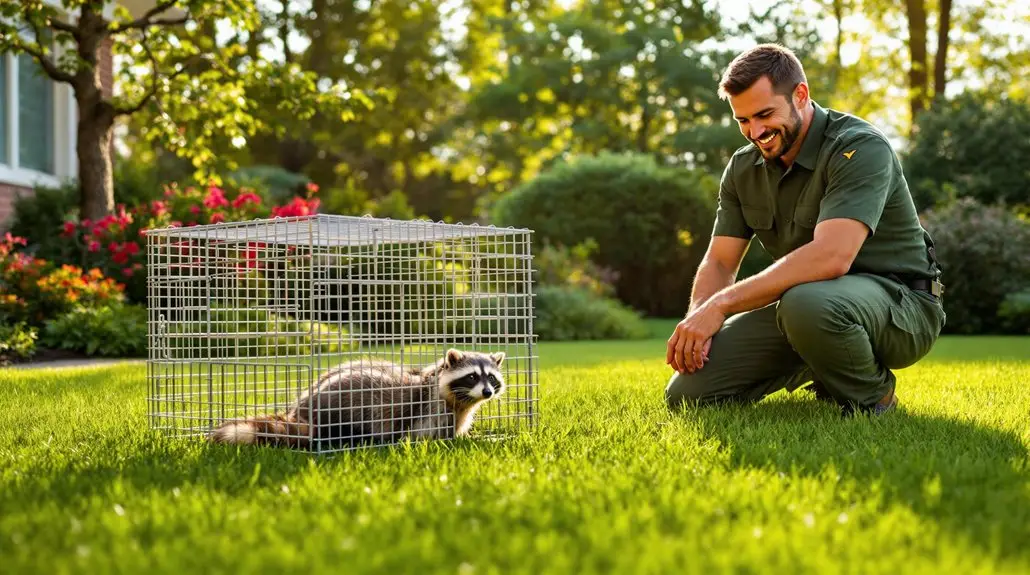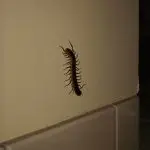Humane wildlife solutions are essential for homeowners dealing with unwelcome animal guests. Start by identifying the species causing trouble, like squirrels or raccoons, and use live traps for secure capture. Use one-way doors to let them exit without returning. You should also seal entry points and secure food sources to prevent further intrusions. Employ natural repellents and habitat modifications for long-term protection. Collaborating with certified professionals guarantees compliance with local regulations while providing eco-friendly solutions. Understanding these methods fully can help maintain harmony in your home, so keep exploring for the best practices to protect your space effectively.
Key Insights
- Conduct thorough property inspections to identify access points and evaluate the extent of wildlife-related damage.
- Utilize humane capture techniques, such as live traps, to remove intruding wildlife without harm.
- Implement exclusion strategies by sealing entry points with durable materials to prevent future intrusions.
- Modify habitats by eliminating food sources and reducing clutter to deter wildlife presence effectively.
- Collaborate with certified humane professionals and local wildlife organizations for expert guidance and support in wildlife management.
Understanding Humane Wildlife Methods

When dealing with wildlife intrusions, understanding humane methods is imperative for effective resolution. The first step is accurately identifying the species causing the issue. Common culprits like squirrels, raccoons, birds, and bats each have unique behaviors and habits that you’ll want to comprehend. A thorough property inspection helps you determine how these animals are accessing your home, which is essential for choosing the right removal methods.
Once you’ve identified the problem, consider using live traps for humane capture. These traps allow you to catch the animals without causing harm. Baiting the traps with food can lure them in effectively. Remember, ensuring the animals are unharmed is critical, so handle the traps with care. Compliance with local wildlife regulations is also necessary, as some areas have specific guidelines regarding trapping and relocation. Humane trapping is a standard method in humane wildlife control practices that ensures ethical treatment.
Relocation is another humane option, where you transport the animal to a secure distance from your home. The relocation site must offer the necessary resources for their survival, and be mindful of any regulations that might limit how far you can move them—like the one-kilometer rule in Ontario.
Lastly, consider preventative measures to avoid future issues. Seal entry points using durable materials like mesh or steel wool, and make property modifications, such as trimming tree branches.
Effective Eviction Techniques
When it comes to evicting unwanted wildlife, effective techniques can make all the difference. You can start by implementing one-way doors that allow animals to exit securely while preventing their return. Additionally, utilizing humane animal removal methods ensures that the process is safe and stress-free for the wildlife involved. Monitoring their activity and analyzing the root causes of their presence will help you create a lasting solution.
One-Way Door Implementation
How can homeowners effectively evict unwanted wildlife while guaranteeing a humane approach? One-way doors offer a practical solution. These devices allow animals to push through and exit your home, but they can’t return. This means you can help critters like squirrels, raccoons, bats, and birds leave without harm. The spring-loaded mechanism guarantees they can’t re-enter, keeping your space protected and secure. Additionally, wild animals often have multiple dens, which means if one den is blocked, they will relocate to another, making one-way doors an effective option for managing their movement.
Using one-way doors minimizes direct contact with wildlife, reducing the risk of bites, scratches, and disease transmission. Plus, it prevents mother animals from causing extensive damage while trying to reach their young. You’ll feel good knowing you’re taking a humane route that doesn’t involve trapping or relocating, both of which can be tricky and stressful.
Before installation, check for any baby animals to avoid separating them from their mothers. Guarantee all other potential entry points are sealed so the animals can’t find another way back in.
If you’re unsure about the process, consider hiring professional technicians. They can expertly identify entry points, handle any baby animals carefully, and guarantee a smooth and humane eviction process for everyone involved.
Monitoring Animal Activity
After installing one-way doors, keeping an eye on animal activity is essential for guaranteeing your eviction efforts are effective. Regular monitoring helps you identify any potential re-entry points and determine if your strategies are working. NaturePest’s commitment to organic pest control ensures that your environment remains safe while addressing wildlife concerns.
Here’s a quick guide to help you with monitoring:
| Task | Method | Notes |
|---|---|---|
| Identify Entry Points | Inspect various areas | Use flashlights for better visibility |
| Use Repellents | Apply natural deterrents | Confirm they’re eco-friendly |
| Document Findings | Keep a record of entry points | Helps in sealing later |
When you inspect attics, walls, and crawlspaces, look for gaps or holes. Utilizing non-toxic repellents, like cayenne pepper, can help deter animals. Remember to keep your yard tidy by removing food sources and debris. This proactive approach not only helps with eviction but fosters a welcoming environment. Implementing exclusion techniques is critical to ensure that wildlife does not return after eviction.
Frequent trapping and release can also be a humane solution. Place live traps in areas of activity and check them regularly. By following these steps, you’ll effectively monitor animal activity and create a peaceful home environment for everyone.
Root Cause Analysis
Understanding the root causes of wildlife intrusion is essential for effective eviction techniques. Start by identifying what attracts these animals to your home. Remove food sources like pet food, garbage, and fallen fruit to make your space less appealing. Secure trash bins with wildlife-resistant containers and keep outdoor areas tidy. Additionally, maintaining regular maintenance and cleanliness can significantly reduce the likelihood of wildlife encounters.
Next, consider habitat modification. Trim overhanging tree branches that provide easy access to your roof. Additionally, use natural deterrents such as cayenne pepper, vinegar, or peppermint oil around entry points to repel unwanted guests. It’s also important to recognize that squirrels seek environments with abundant food sources, which often leads them toward human habitation.
Once you’ve addressed these factors, it’s time to implement eviction techniques. Use loud music or talk radio to create noise and make your home uncomfortable for wildlife.
Bright lights or motion-activated sprinklers can startle them away effectively.
Importance of Exclusion Strategies
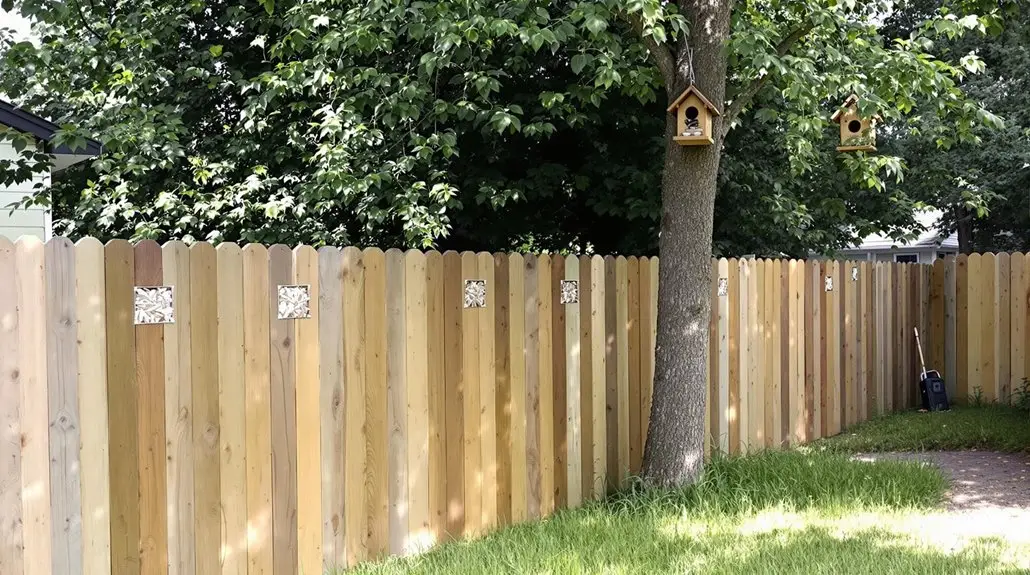
Exclusion strategies are crucial for homeowners looking to protect their properties from unwanted wildlife. By identifying and sealing entry points like gaps around chimneys, rooflines, vents, and foundation cracks, you can effectively prevent animals from entering your home.
Using materials such as mesh, hardware cloth, caulk, or steel wool to fill these gaps is a straightforward way to bolster your defenses. Installing door sweeps and repairing household screens also plays a fundamental role in keeping unwanted visitors out. Additionally, understanding the common pests in your area can help you tailor your exclusion strategies effectively to combat specific threats, such as termites and rodents.
Not only do these strategies help in blocking access to animals like raccoons and squirrels, but they also minimize the threat of structural damage and electrical hazards. This proactive approach saves you time and money on costly repairs, maintaining your home’s integrity and value. Moreover, implementing effective exclusion techniques can act as an impermeable barrier against wildlife entry, further enhancing your home’s defenses.
You’ll enjoy a secure, pest-free environment, which is crucial for your family’s peace of mind.
Moreover, exclusion strategies greatly reduce health risks associated with pests. By preventing wildlife from nesting in or near your home, you’ll lessen the chances of encountering parasites or diseases that these animals may carry. This not only protects your well-being but also aligns with legal requirements to safeguard certain species.
Implementing these strategies is generally easier and more cost-effective than other methods. You won’t need specialized equipment or training; simple, readily available materials can create a long-term solution, keeping your home secure from future intrusions.
Adopting these exclusion strategies fosters a sense of belonging, ensuring that your home remains a sanctuary for you and your loved ones.
Monitoring With Technology
Monitoring wildlife effectively has never been easier thanks to advancements in technology. With tools like GPS tracking collars, you can keep tabs on local wildlife in real time, ensuring that you’re always informed about their movements. This isn’t just useful for tracking; it aids in deploying anti-poaching units and understanding animal behavior patterns.
Automated alerts can signal you when there’s a significant change in wildlife activity, enhancing your response time. You’ll appreciate the convenience of cloud-based record-keeping, which lets you access essential data anytime and anywhere. It’s all about making your monitoring efforts more effective without infringing on wildlife’s natural habitat.
Using machine learning models, technology can now classify images from remote cameras, reducing false triggers and making your monitoring more accurate. This means less time sifting through images and more time focusing on what truly matters—conservation.
Moreover, with 41,415 species on the IUCN Red List, tracking technology plays a crucial role in ensuring the survival of threatened wildlife. Non-invasive methods, like footprint analysis, allow you to track endangered species while being considerate to the environment. Real-time video feeds from cellular cameras grant you a front-row seat to observe wildlife behavior, helping you refine your techniques.
Plus, with remote access, you can monitor even when you’re not there. By embracing these tech solutions, you’re not just a homeowner; you’re part of a community dedicated to humane wildlife management. Together, you can foster a secure coexistence between humans and animals in your area.
Service Areas and Coverage
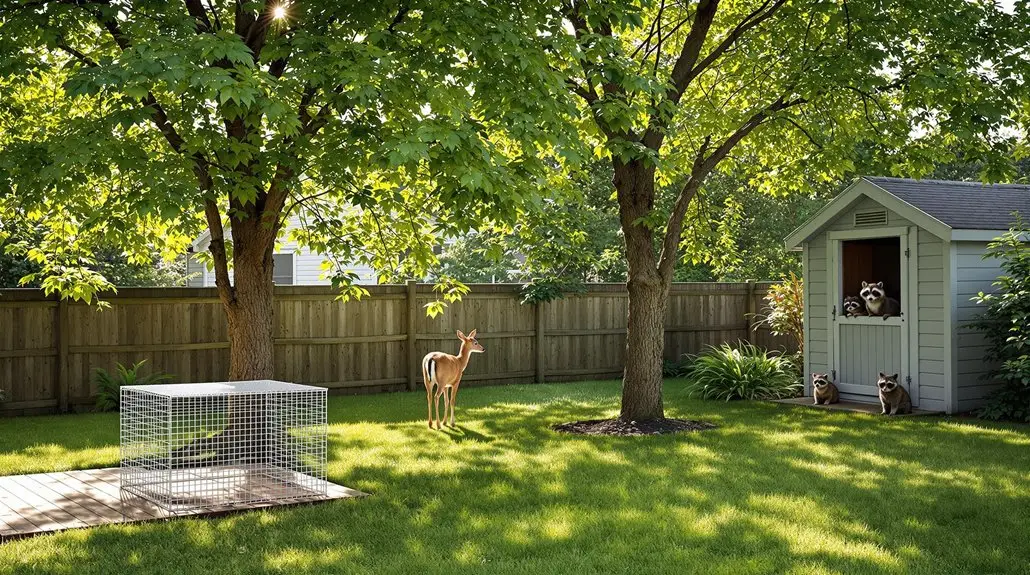
Effective wildlife solutions require a keen awareness of service areas and coverage.
Whether you live in St. Louis City, St. Louis County, or the surrounding areas, our services are designed to meet your unique needs. We recognize that wildlife issues can arise in various contexts, so we cater to both residential and commercial structures. Your home, business, school, church, nursing home, or hospital deserves protection from unwanted wildlife encounters. Our commitment to humane practices ensures that we address the root causes of wildlife conflicts effectively.
Our coverage extends to urban, rural, and suburban settings, ensuring that no matter where you are, you can access humane wildlife solutions.
We also address specific locations such as patios, decks, sheds, and outbuildings, so you can enjoy your outdoor spaces without worry. Your lawn and garden, as well as water bodies like ponds and streams, are all part of our service area.
Compliance and Certifications
When it comes to addressing wildlife issues, compliance and certifications play an essential role in ensuring you’re receiving the best service possible. You want to know that the team you hire isn’t only knowledgeable but also committed to humane practices.
Look for companies certified humane by the Humane Society of the United States and members of reputable organizations like the Humane Wildlife Control Association. These affiliations show that they adhere to high standards and are part of a community that prioritizes ethical wildlife management.
Moreover, it’s important that the team has proper licensing and insurance. Fully licensed, bonded, and insured professionals comply with local health and security codes, ensuring that your home and the wildlife are treated with care. They should also focus on addressing the root causes of wildlife conflicts to prevent future issues effectively.
They should also provide guarantees against animal re-entry and offer a solid commitment to preventing new intrusions for up to ten years.
Experience matters, too. A well-trained team that understands wildlife behavior and employs scientifically sound methods gives you peace of mind.
Whether they’re dealing with raccoons, bats, or squirrels, their expertise is essential in resolving conflicts humanely.
Additional Wildlife Management Services

Many homeowners face the challenge of managing wildlife intrusions, and additional wildlife management services can provide effective solutions. You can rely on humane trapping methods that prioritize the security and well-being of the animals.
For infestations, repeater traps can capture multiple squirrels, allowing for efficient removal. By sealing all but one entry hole and utilizing exclusion funnels, you can guide unwanted guests out of your space, preventing further issues.
Once trapped, animals are relocated a protected distance away, minimizing the chance of re-infestation. Regular monitoring of traps guarantees that the process remains efficient and humane. Additionally, our focus on humane and ethical practices ensures that each step is taken with the utmost respect for all species involved.
Beyond removal, damage repair and prevention are vital. By sealing entry holes with sturdy materials like metal flashing or wire mesh, you can fortify your home against future invasions. It’s also important to inspect and repair any damage caused by wildlife, including woodwork and electrical wires.
You’ll appreciate species-specific solutions that cater to the unique habits of local wildlife. Understanding the birthing seasons and behaviors can help you avoid orphaning young animals during removal.
Additionally, educational and preventive services can empower you with knowledge on maintaining a wildlife-free property. Ongoing support, property assessments, and conflict resolution resources guarantee you feel connected and supported as you navigate these challenges.
With these additional services, you can create a protected and welcoming environment for both your family and local wildlife.
Philosophy of Coexistence
Coexisting with urban wildlife isn’t just about tolerance; it’s vital for a healthy ecosystem.
By understanding the ecological benefits of these animals, you can foster a balanced environment while preventing conflicts.
Taking proactive steps guarantees that both you and your wild neighbors can thrive together in harmony.
Importance of Coexistence
In today’s world, embracing the philosophy of coexistence is vital for both human and wildlife well-being. Coexistence isn’t just about sharing space; it’s about adapting to one another’s needs while managing the inevitable conflicts that arise. You may face challenges when wildlife ventures into your area, but understanding that these interactions are part of a larger ecosystem can shift your perspective.
Effective governance and social norms that favor wildlife play an important role in fostering a harmonious environment. By recognizing the subjective nature of tolerance towards wildlife risks, you can engage in meaningful conversations with your neighbors about how to manage these interactions.
Participatory approaches to decision-making guarantee that everyone’s voice is heard, creating a sense of belonging in your community.
While conflicts can threaten conservation and livelihoods, they also present opportunities for collaboration. By working together to develop strategies that balance human and wildlife interests, you’ll contribute to a sustainable future.
Ultimately, embracing coexistence not only supports wildlife populations but also enriches your community, fostering a deeper connection to the natural world around you.
Ecological Benefits of Wildlife
The ecological benefits of wildlife are profound and far-reaching, impacting both natural environments and human communities. When you embrace wildlife, you support balanced ecosystems that regulate prey populations and maintain stability essential for your well-being. Large carnivores, for instance, play a significant role by controlling herbivore numbers, which promotes healthy plant growth and preserves our rivers. Without these species, you might witness detrimental effects like deforestation and increased diseases.
Moreover, wildlife contributes to necessary ecosystem services such as pollination and nutrient cycling, enriching your environment. Diverse wildlife fosters complex food webs that enhance resilience against changes, which is critical for agriculture and food security in your community. Additionally, effective pest control methods can help maintain a harmonious balance between human habitats and wildlife, preventing infestations while respecting natural ecosystems, showcasing the importance of natural pest control methods.
Living alongside wildlife can also create new economic opportunities, like ecotourism, boosting local livelihoods. By recognizing the value of coexistence, you help cultivate a sense of belonging in your community, promoting environmental justice and improving the quality of life for everyone involved.
In short, coexisting with wildlife not only nurtures ecosystems but also strengthens the bond between you, your community, and the natural world. Embracing this philosophy can lead to a healthier, more sustainable future for all.
Long-term Conflict Prevention
Long-term conflict prevention with wildlife hinges on understanding and addressing the root causes of encounters. You can create a harmonious coexistence by identifying entry points, evaluating environmental factors, and examining structural vulnerabilities. Here’s how you can approach this:
| What to Address | Emotional Impact |
|---|---|
| Entry points for wildlife | Peace of mind knowing your home is secure |
| Environmental attractants | Joy in maintaining a healthy habitat |
| Vulnerable structures | Confidence in protecting your space |
| Wildlife behavior | Respect for nature’s cycle and needs |
Using humane eviction methods is crucial. One-way doors and exclusion funnels allow animals to leave without returning. After eviction, wildlife-proof your home with sturdy materials and conduct regular inspections. Modify your surroundings to discourage future visits, ensuring a serene space for both you and the wildlife.
Long-term monitoring is key. Keep an eye on animal activity and maintain your wildlife-proofing measures. By taking these steps, you’ll foster a sense of belonging for both yourself and the wildlife in your area, creating a more peaceful community and environment for everyone involved.
Addressing Root Causes
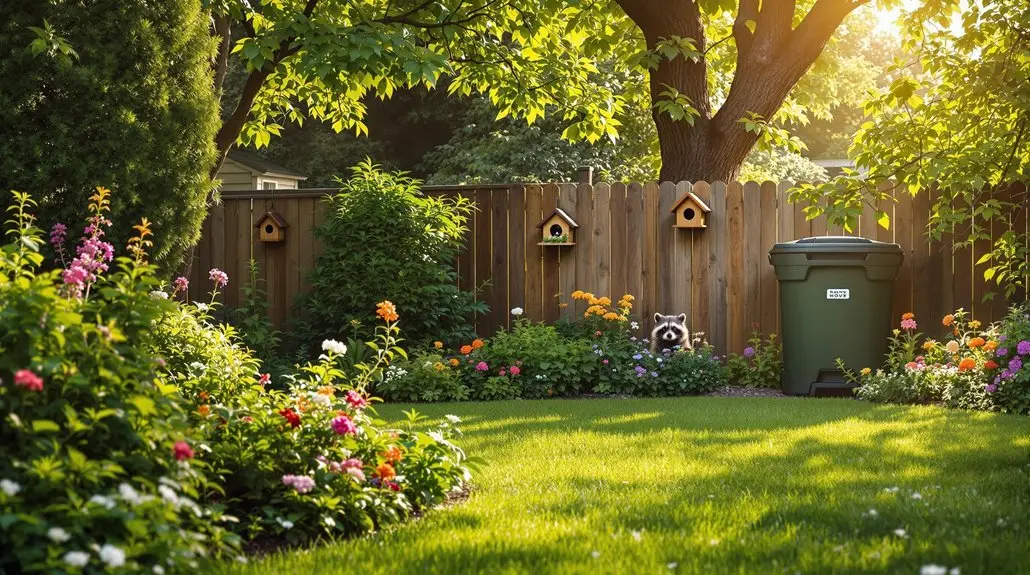
Addressing root causes of wildlife conflicts is vital for effective solutions that prevent future issues. To begin, you’ll want to identify entry points around your home. Consider using digital motion-activated cameras to monitor animal activity and pinpoint species and access points.
Conduct a thorough inspection of your building to locate openings that attract wildlife. Recognizing that human-built structures are part of their natural environment will help you understand their behavior and entry patterns.
Once you’ve identified these entry points, implementing eviction techniques is essential. You can use one-way doors that allow animals to exit without re-entering, and exclusion funnels can guide them out securely.
Make sure to seal all but one entry hole and use traps or funnels over the remaining hole, ensuring a humane approach without relocation or lethal control. If you find young animals, take care to reunite them with their parents when possible.
Preventing future intrusions involves more than just eviction. Installing custom animal-proofing for all entry and potential entry holes is key. Use sturdy materials like metal flashing or wire mesh to seal these openings effectively.
Consider modifying your habitat and cleaning up debris to deter wildlife from your space. By addressing these root causes, you create a welcoming environment that respects both your needs and those of the wildlife around you, ensuring harmonious coexistence.
Expertise in Wildlife Solutions
When it comes to wildlife issues, you want experienced specialists who know how to resolve conflicts effectively.
These experts employ eco-friendly approaches that prioritize humane solutions, ensuring both your home and the wildlife are treated with respect.
With their extensive knowledge, they can tailor strategies to meet your specific needs while protecting the environment.
Experienced Wildlife Specialists
Finding the right wildlife specialist can make all the difference when dealing with unwanted critters in your home. Experienced wildlife specialists in Connecticut bring the expertise needed to handle various pest issues humanely and effectively.
You’ll want to choose a team that understands both the animals and your needs.
Here are a few top options to evaluate:
- NCS Wildlife Solutions: With over 20 years of experience, they offer extensive services including attic restoration and entry point sealing, ensuring your home stays critter-free.
- Critter Control: They customize removal processes based on your specific infestation, focusing on humane techniques to protect your property and its inhabitants.
- Animal Wildlife Solutions: Licensed and insured, they excel in identifying entry points and use proven methods for exclusion, keeping your home secure from future issues.
Choosing an experienced wildlife specialist not only alleviates your immediate concerns but also fosters a sense of security in your living environment.
You deserve to feel protected in your home, and these professionals are here to help you achieve that peace of mind.
Comprehensive Conflict Resolution
Understanding the complexities of wildlife conflicts is vital for homeowners looking to maintain a peaceful living environment. By accurately evaluating the situation, you can identify the species involved and gauge the damage severity. This process is essential for developing effective conflict resolution strategies.
Here’s a quick overview of the steps involved:
| Conflict Assessment | Conflict Resolution Strategies |
|---|---|
| Identify species causing conflict | Technical assistance for DIY solutions |
| Evaluate affected resources | Install anti-chewing deterrents |
| Gauge human and wildlife impact | Use non-lethal methods |
| Monitor with digital tools | Sequential management techniques |
Preventive measures are equally important. Sealing entry points and installing one-way doors can help keep wildlife at bay. Continuous monitoring helps guarantee that your strategies remain effective, allowing for adjustments based on outcomes.
Eco-Friendly Approaches
In today’s world, adopting eco-friendly approaches to wildlife solutions not only protects your home but also promotes a harmonious coexistence with nature.
You can take practical steps to guarantee that both your living space and local wildlife thrive. Here are some effective methods:
- Humane Trapping and Relocation: Use live traps to capture animals without causing harm, and promptly release them in accordance with local guidelines, minimizing stress during the process.
- Exclusion Techniques: Identify and seal entry points with wildlife-friendly materials, allowing animals to exit securely while preventing re-entry.
- Natural Repellents: Utilize natural deterrents like peppermint oil or install motion-activated sprinklers to discourage wildlife from invading your space.
Collaborating With Local Resources
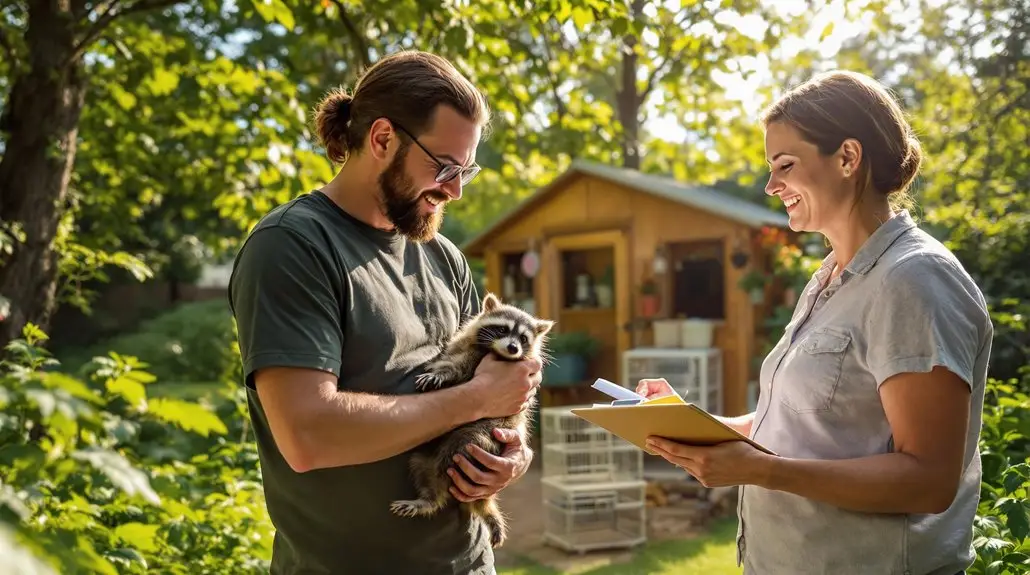
Collaborating with local resources is essential for homeowners seeking humane solutions to wildlife issues. By teaming up with local wildlife rehabilitators, you can guarantee that injured or orphaned animals receive the proper care they need. These professionals can guide you on how to handle animals you might find in your yard and help you identify the right facilities for specific wildlife. They often work to reunite young animals with their parents, which is a comforting thought for any compassionate neighbor.
Additionally, connecting with non-profit organizations like the Humane Society of the United States guarantees you stay informed about humane wildlife control guidelines. By participating in community events and educational programs, you’ll not only learn more but also meet like-minded individuals who share a passion for wildlife conservation.
Engaging with community resources is another way to address wildlife concerns. You can obtain advice on managing lawn and garden critters without resorting to harmful chemicals. Schools and local communities often collaborate to promote humane management practices, and your involvement can make a significant difference.
Lastly, by partnering with local businesses, you can advocate for humane solutions in commercial settings. Whether it’s cleaning up waterways or modifying habitats, every small effort counts in creating a balanced environment. Together, with local resources, you can foster a community that values and protects wildlife, making your neighborhood a better place for all.
Long-Term Effective Strategies
Creating a sustainable solution for wildlife conflicts requires a proactive approach that gets to the root of the problem. Instead of merely removing animals, focus on long-term strategies that prevent future issues while respecting both wildlife and your home.
By understanding the habits and needs of local wildlife, you can create an environment that discourages conflicts.
Here are some effective strategies to contemplate:
- Seal Entry Points: Identify and secure potential entryways using animal-proof materials and one-way doors.
- Monitor Activity: Set up digital motion-activated cameras to track wildlife movement and pinpoint access points.
- Modify Habitats: Adjust your property to deter wildlife, such as reducing clutter and securing garbage.
You’ll find that these methods not only help in evicting unwanted guests ethically but also guarantee that young animals remain with their parents.
By prioritizing humane techniques, you create a protected space for both your family and the environment.
Additionally, contemplate joining the Humane Wildlife Control Association to connect with certified operators who adhere to high standards. They can provide competitive, non-lethal solutions tailored to your specific situation.
Frequently Asked Questions
How Can I Prevent Wildlife From Entering My Home?
To prevent wildlife from entering your home, start by inspecting your exterior for cracks and gaps.
Seal these openings with caulk or steel wool. Install mesh screens over vents and check doors and windows for secure weather stripping.
Keep your yard tidy by trimming shrubs and removing debris. Store food securely and use natural repellents like vinegar around entry points.
What Should I Do if I Find a Baby Animal?
If you find a baby animal, first assess its condition and look for the mother nearby.
Keep your distance and don’t touch it unless necessary.
Create a secure space by placing it in a warm, protected container.
Avoid feeding it, as that can cause harm. Instead, monitor the area for the mother’s return.
If you’re unsure, contact a local wildlife rehabilitation center for guidance and support.
You’re doing the right thing by caring!
Are There Any Seasonal Wildlife Concerns I Should Be Aware Of?
As the seasons shift, think of wildlife as a vibrant dance, each animal playing its part.
In spring, you might spot raccoons and squirrels searching for cozy nesting spots, while summer brings nocturnal visitors like coyotes.
Fall invites squirrels to gather food, and in winter, creatures seek warmth, sometimes in your home.
Stay vigilant and manage your yard to create a welcoming space for you, not uninvited wildlife.
Your home should be your sanctuary.
How Do I Know if I Need Professional Wildlife Assistance?
You’ll know you need professional wildlife assistance if you spot signs of injury or illness, like bleeding or abnormal behavior.
If an animal shows distress after contact with your pets, it’s time to call for help.
You should also reach out if you find orphaned or abandoned animals, like a crying fawn or baby birds without feathers.
Always prioritize their protection and well-being, and never hesitate to seek expert guidance.
What Are the Costs Associated With Humane Wildlife Services?
When critters invade your space, it can feel like an uninvited party.
The costs for humane wildlife services can range widely. You’re looking at around $191 to $576 on average, with specific animals like squirrels costing between $200 and $600.
If you’ve got a larger issue, such as raccoons or bats, that could push costs up to $1,500 or more.
Create Harmony at Home: Embrace Humane Wildlife Solutions with NaturePest Holistic Pest Control!
In a world where nature and home collide, you can be the guardian of harmony with NaturePest Holistic Pest Control. By embracing humane wildlife solutions, you’re not just evicting unwelcome guests; you’re weaving a tapestry of coexistence. Imagine a serene backyard, where the song of birds dances with the rustle of leaves, all thanks to your proactive efforts. With expert guidance and a commitment to long-term strategies, you’re nurturing a peaceful sanctuary for both you and your wild neighbors.
Take the first step towards a harmonious home environment today! Contact NaturePest Holistic Pest Control and discover how our humane approaches can transform your space into a wildlife-friendly oasis. Let’s work together to create a balance that benefits both you and the nature around you!

